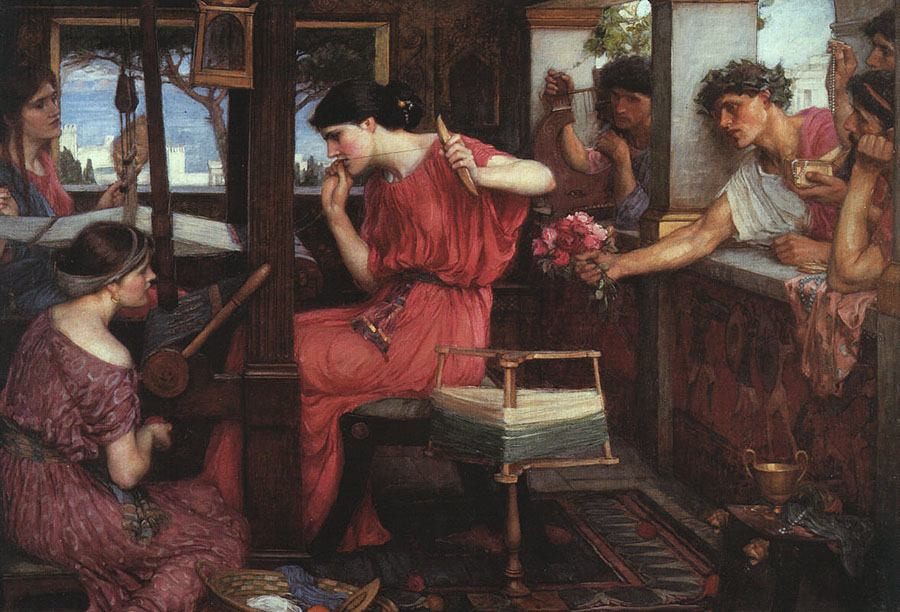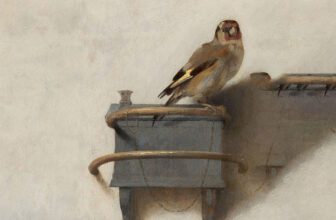
“Keep It Silence – No One has to Know What You Do” :
Meaning of Penelope and the Suitors Painting
In the softly lit galleries of the Aberdeen Art Gallery in Scotland, one painting seems to capture not just the eye, but the timeless essence of patience, fidelity, and the feminine spirit. It is Penelope and the Suitors (1912), a magnificent canvas by the famed British artist John William Waterhouse. This masterwork, rich with Pre-Raphaelite detail and mythological gravitas, weaves together threads of classical literature, Victorian moral ideals, and artistic mastery into a single, poignant moment.
But what exactly is happening in this painting? Why did Waterhouse choose this particular scene? And what symbols lie hidden within its flowing fabrics, expressive faces, and architectural backdrop? To understand Penelope and the Suitors is to embark on a journey through mythology, romanticism, and the very soul of storytelling in art.
Who Was John William Waterhouse?
Before diving into the painting itself, we must understand its creator. John William Waterhouse (1849–1917) was a British painter best known for his association with the later phase of the Pre-Raphaelite Brotherhood. Though he was born after the original Brotherhood had disbanded, Waterhouse found deep inspiration in their ideals, especially their emphasis on myth, literature, and detailed naturalism.
Waterhouse’s body of work frequently focuses on female figures from mythology, history, and literature, women like Ophelia, Circe, and Psyche, depicted with an intense inner world, emotional complexity, and symbolic richness. Penelope and the Suitors, one of his later works, stands as a culmination of his mature style and lifelong interests.
What Is the Story Behind the Painting?
Penelope and the Suitors draws its narrative from Homer’s Odyssey, an epic poem that has influenced Western literature for millennia. In this tale, Odysseus, king of Ithaca, embarks on a long and perilous journey home after the Trojan War, leaving his faithful wife, Penelope, behind.
For twenty years, Penelope waits for Odysseus’s return, ten years of war and ten years of wandering. In his absence, a crowd of arrogant suitors invades her home, pressing her to choose a new husband and assume Odysseus is dead. To delay this fate, Penelope devises a clever ruse: she promises to choose a suitor once she finishes weaving a funeral shroud for her father-in-law. Yet each night, under cover of darkness, she unravels the day’s progress, buying time with her silent rebellion.
This act of quiet resistance, unwavering loyalty, and strategic intellect becomes the emotional core of Waterhouse’s painting.
What Is Happening in “Penelope and the Suitors”?
In Waterhouse’s painting, we see Penelope in a moment of quiet, almost melancholic contemplation. She sits at her loom, clothed in rich yet muted robes, her posture graceful but withdrawn. Her head is slightly turned away from the group of three men, the suitors, who gather to her right, vying for her attention with gifts, music, and flattery.
The suitors appear engaged, eager, perhaps even desperate. One offers a bouquet of flowers, another strums a lyre, and the third leans forward as if to make his case. Yet Penelope does not look at them. Her gaze is fixed beyond the frame, hinting at the invisible presence of Odysseus in her mind and heart.
The atmosphere is one of tension, not of violence or chaos, but of an emotional standoff. The physical space between Penelope and the suitors mirrors the emotional and moral chasm that divides them.
Symbolism in “Penelope and the Suitors”
Waterhouse was a master of symbolism, and this painting is no exception. Every element serves to deepen the story and its emotional resonance.
1. The Loom
The most powerful symbol in the painting is Penelope’s loom. It is the tool of her resistance, her anchor in a world that demands she move on. In many mythological traditions, weaving symbolizes fate, time, and the feminine creative force. Here, it becomes a weapon of quiet defiance. Her refusal to complete the weaving is a refusal to abandon her faith.
2. The Suitors’ Gifts
The flowers and music offered by the suitors reflect their superficial attempts to win her love. While beautiful, these tokens pale in comparison to the depth of Penelope’s loyalty. Their performative courtship highlights the shallowness of their intentions versus Penelope’s profound emotional landscape.
3. Penelope’s Gaze
Perhaps the most understated yet moving symbol is Penelope’s averted gaze. She does not acknowledge the men around her. Her eyes are fixed on memory, hope, or something beyond her physical surroundings, possibly even a vision of Odysseus himself. This detachment signals both her inner strength and her isolation.
4. Architectural Details
The marble columns and classical architecture frame Penelope’s world with timelessness and restraint. It’s a nod to the Greek setting, but also a way to heighten the stoic dignity with which she holds her emotional vigil. The open courtyard invites the viewer into a moment of intimate stillness within a public drama.
Themes and Deeper Meanings
1. Loyalty and Feminine Strength
Penelope is often seen as the epitome of wifely virtue in classical literature. However, Waterhouse does more than depict her as merely loyal; he elevates her to an emblem of strength and autonomy. Her refusal to choose a new husband is not passive submission but an act of calculated endurance. She manipulates time, outwits her adversaries, and holds her family’s legacy intact.
2. The Power of Patience
In a world that often values action over restraint, Penelope’s heroism lies in her patience. Unlike Odysseus, whose trials involve monsters and storms, Penelope’s battles are internal, domestic, and emotional. Yet they are no less heroic.
3. Male Desire vs. Female Agency
The contrast between the suitors and Penelope creates a dialogue about gender dynamics. The men seek to possess and control; Penelope seeks to preserve and wait. Her refusal to capitulate makes her a rare figure of feminine agency in ancient, and even modern, narratives.
4. Memory and Absence
Waterhouse masterfully conveys the idea that Odysseus, though absent, is the most present figure in the painting. His unseen presence haunts every corner. Penelope’s emotional life revolves around him, not in a needy or weak way, but as a testament to enduring love that transcends physical separation.
How Was Penelope and the Suitors Painting Created?
Painted in 1912, Penelope and the Suitors was one of Waterhouse’s last great works before his death in 1917. By this point in his career, his style had matured, blending Pre-Raphaelite intricacy with an impressionistic softness that lent emotional depth to his subjects.
Waterhouse used oil on canvas, a medium that allowed him to create layers of color and texture. His use of color here is particularly notable, earthy tones dominate, punctuated by the more vibrant garb of the suitors, drawing a visual line between the grounded, rooted figure of Penelope and the decorative, showy presence of her would-be suitors.
It’s likely Waterhouse used live models, as was his practice, possibly combining multiple sketches and studies to compose the final scene. His attention to detail in Penelope’s posture, the folds of her robe, and the distant gaze suggests a deep psychological study and emotional investment.
What Kind of Art Is Penelope and the Suitors ?
This painting falls within the Romantic and Pre-Raphaelite traditions. While technically post-Pre-Raphaelite (the original Brotherhood peaked in the 1850s), Waterhouse embraced their ideals:
Emphasis on literary subjects
Use of vivid color and fine detail
Focus on symbolic storytelling
Idealization of beauty and emotion
Penelope and the Suitors is a narrative painting, designed not simply to depict a person or place, but to tell a story and provoke reflection. It’s figurative, allegorical, and deeply literary, drawing from classical myth to address timeless human concerns.
Where Is the Penelope and the Suitors Painting Now?
Penelope and the Suitors is housed in the Aberdeen Art Gallery, Scotland. It was gifted to the gallery in 1924 by Sir George James Frampton and remains one of its most treasured works.
The painting is displayed as part of the gallery’s permanent collection and has been featured in various exhibitions on Victorian art, Pre-Raphaelitism, and classical mythology. Its placement in Aberdeen may be somewhat off the beaten path for international visitors, but for those who make the journey, it is an emotional and artistic experience not easily forgotten.
Why Penelope and the Suitors Painting Still Matters
More than a century after it was painted, and nearly three millennia after Homer first told her tale, Penelope still speaks to us. In Waterhouse’s hands, she becomes a symbol not only of marital fidelity but of inner strength, quiet intelligence, and moral courage.
Penelope and the Suitors reminds us that heroism doesn’t always roar. Sometimes, it weaves by candlelight. Sometimes, it waits while the world pressures it to move on. In a culture obsessed with immediacy and spectacle, Waterhouse gives us a portrait of endurance that feels more radical than ever.
This is not merely a painting. It is a meditation on love, time, and the resilient spirit of those who remain faithful, not just to others, but to themselves.




